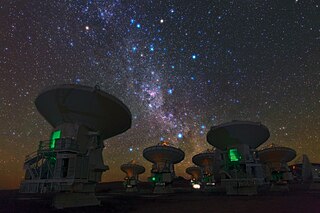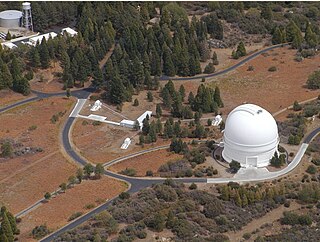
Radio astronomy is a subfield of astronomy that studies celestial objects at radio frequencies. The first detection of radio waves from an astronomical object was in 1933, when Karl Jansky at Bell Telephone Laboratories reported radiation coming from the Milky Way. Subsequent observations have identified a number of different sources of radio emission. These include stars and galaxies, as well as entirely new classes of objects, such as radio galaxies, quasars, pulsars, and masers. The discovery of the cosmic microwave background radiation, regarded as evidence for the Big Bang theory, was made through radio astronomy.

Very-long-baseline interferometry (VLBI) is a type of astronomical interferometry used in radio astronomy. In VLBI a signal from an astronomical radio source, such as a quasar, is collected at multiple radio telescopes on Earth or in space. The distance between the radio telescopes is then calculated using the time difference between the arrivals of the radio signal at different telescopes. This allows observations of an object that are made simultaneously by many radio telescopes to be combined, emulating a telescope with a size equal to the maximum separation between the telescopes.

The Karl G. Jansky Very Large Array (VLA) is a centimeter-wavelength radio astronomy observatory in the southwestern United States. It lies in central New Mexico on the Plains of San Agustin, between the towns of Magdalena and Datil, approximately 50 miles (80 km) west of Socorro. The VLA comprises twenty-eight 25-meter radio telescopes deployed in a Y-shaped array and all the equipment, instrumentation, and computing power to function as an interferometer. Each of the massive telescopes is mounted on double parallel railroad tracks, so the radius and density of the array can be transformed to adjust the balance between its angular resolution and its surface brightness sensitivity. Astronomers using the VLA have made key observations of black holes and protoplanetary disks around young stars, discovered magnetic filaments and traced complex gas motions at the Milky Way's center, probed the Universe's cosmological parameters, and provided new knowledge about the physical mechanisms that produce radio emission.

The Multi-Element Radio Linked Interferometer Network (MERLIN) is an interferometer array of radio telescopes spread across England. The array is run from Jodrell Bank Observatory in Cheshire by the University of Manchester on behalf of Science and Technology Facilities Council (STFC).
Aperture synthesis or synthesis imaging is a type of interferometry that mixes signals from a collection of telescopes to produce images having the same angular resolution as an instrument the size of the entire collection. At each separation and orientation, the lobe-pattern of the interferometer produces an output which is one component of the Fourier transform of the spatial distribution of the brightness of the observed object. The image of the source is produced from these measurements. Astronomical interferometers are commonly used for high-resolution optical, infrared, submillimetre and radio astronomy observations. For example, the Event Horizon Telescope project derived the first image of a black hole using aperture synthesis.

Onsala Space Observatory (OSO), the Swedish National Facility for Radio Astronomy, provides scientists with equipment to study the Earth and the rest of the Universe. The observatory operates two radio telescopes in Onsala, 45 km south of Gothenburg, and takes part in several international projects. Examples of activities:

The Navy Precision Optical Interferometer (NPOI) is an American astronomical interferometer, with the world's largest baselines, operated by the Naval Observatory Flagstaff Station (NOFS) in collaboration with the Naval Research Laboratory (NRL) and Lowell Observatory. The NPOI primarily produces space imagery and astrometry, the latter a major component required for the safe position and navigation of all manner of vehicles for the DoD. The facility is located at Lowell's Anderson Mesa Station on Anderson Mesa about 25 kilometers (16 mi) southeast of Flagstaff, Arizona (US). Until November 2011, the facility was known as the Navy Prototype Optical Interferometer (NPOI). Subsequently, the instrument was temporarily renamed the Navy Optical Interferometer, and now permanently, the Kenneth J. Johnston Navy Precision Optical Interferometer (NPOI) – reflecting both the operational maturity of the facility, and paying tribute to its principal driver and retired founder, Kenneth J. Johnston.

The Palomar Testbed Interferometer (PTI) was a near infrared, long-baseline stellar interferometer located at Palomar Observatory in north San Diego County, California, United States. It was built by Caltech and the Jet Propulsion Laboratory and was intended to serve as a testbed for developing interferometric techniques to be used at the Keck Interferometer. It began operations in 1995 and achieved routine operations in 1998, producing more than 50 refereed papers in a variety of scientific journals covering topics from high precision astrometry to stellar masses, stellar diameters and shapes. PTI concluded operations in 2008 and has since been dismantled.

An astronomical interferometer or telescope array is a set of separate telescopes, mirror segments, or radio telescope antennas that work together as a single telescope to provide higher resolution images of astronomical objects such as stars, nebulas and galaxies by means of interferometry. The advantage of this technique is that it can theoretically produce images with the angular resolution of a huge telescope with an aperture equal to the separation, called baseline, between the component telescopes. The main drawback is that it does not collect as much light as the complete instrument's mirror. Thus it is mainly useful for fine resolution of more luminous astronomical objects, such as close binary stars. Another drawback is that the maximum angular size of a detectable emission source is limited by the minimum gap between detectors in the collector array.
Kenneth Irwin Kellermann is an American astronomer at the National Radio Astronomy Observatory. He is best known for his work on quasars. He won the Helen B. Warner Prize for Astronomy of the American Astronomical Society in 1971, and the Bruce Medal of the Astronomical Society of the Pacific in 2014.

S Coronae Borealis is a Mira variable star in the constellation Corona Borealis. Its apparent magnitude varies between 5.3 and 13.6, with a period of 360 days—just under a year. Within the constellation, it lies to the west of Theta Coronae Borealis, and around 1 degree southeast of the eclipsing binary star U Coronae Borealis.
In optical astronomy, interferometry is used to combine signals from two or more telescopes to obtain measurements with higher resolution than could be obtained with either telescopes individually. This technique is the basis for astronomical interferometer arrays, which can make measurements of very small astronomical objects if the telescopes are spread out over a wide area. If a large number of telescopes are used a picture can be produced which has resolution similar to a single telescope with the diameter of the combined spread of telescopes. These include radio telescope arrays such as VLA, VLBI, SMA, LOFAR and SKA, and more recently astronomical optical interferometer arrays such as COAST, NPOI and IOTA, resulting in the highest resolution optical images ever achieved in astronomy. The VLT Interferometer is expected to produce its first images using aperture synthesis soon, followed by other interferometers such as the CHARA array and the Magdalena Ridge Observatory Interferometer which may consist of up to 10 optical telescopes. If outrigger telescopes are built at the Keck Interferometer, it will also become capable of interferometric imaging.

The Green Bank Interferometer (GBI) is a former radio astronomy telescope located at Green Bank, West Virginia (US) and operated by the National Radio Astronomy Observatory (NRAO). It included three on-site radio telescopes of 85-foot (26m) diameter, designated 85-1, 85-3, and 85-2 and a portable telescope.

3C 286, also known by its position as 1328+307 or 1331+305, is a quasar at redshift 0.8493 with a radial velocity of 164,137 km/s. It is part of the Third Cambridge Catalogue of Radio Sources.
VX Sagittarii is an extreme asymptotic giant branch star located more than 1.5 kiloparsec away from the Sun in the constellation of Sagittarius. It is a pulsating variable star with an unusually large magnitude range. It is also one of the largest stars discovered so far, with a radius varying between 1,350 and 1,940 solar radii (940,000,000 and 1.35×109 km; 6.3 and 9.0 au). It is the most luminous known AGB star, at bolometric magnitude –8.6, which is even brighter than the theoretical limit at –8.0.

Gerard Theodore van Belle is an American astronomer. He is an expert in optical astronomical interferometry.
Edward Fomalont is an American scientist working at the National Radio Astronomy Observatory. He specializes in radio galaxies, X-ray binary systems, astrometry, and general relativity. He has published more than 330 papers in peer-reviewed journals and proceedings of scientific conferences.
The closure phase is an observable quantity in imaging astronomical interferometry, which allowed the use of interferometry with very long baselines. It forms the basis of the self-calibration approach to interferometric imaging. The observable which is usually used in most "closure phase" observations is actually the complex quantity called the triple product. The closure phase is the phase (argument) of this complex quantity.
The Event Horizon Telescope (EHT) is a large telescope array consisting of a global network of radio telescopes. The EHT project combines data from several very-long-baseline interferometry (VLBI) stations around Earth, which form a combined array with an angular resolution sufficient to observe objects the size of a supermassive black hole's event horizon. The project's observational targets include the two black holes with the largest angular diameter as observed from Earth: the black hole at the center of the supergiant elliptical galaxy Messier 87, and Sagittarius A* at the center of the Milky Way.

The Korean VLBI Network (KVN) is a radio astronomy observatory located in South Korea. It comprises three 21-meter radio telescopes that function as an interferometer, using the technique of very-long-baseline interferometry (VLBI).












